Free Courses Sale ends Soon, Get It Now


Free Courses Sale ends Soon, Get It Now



Disclaimer: Copyright infringement not intended.
Introduction
In the past 8 years, India’s Bio-Economy has grown almost tenfold and currently stands at US $ 80 Bn. In the next 8 years, it is expected to nearly quadruple and reach US$ 300 Bn. Stretching over crucial sectors like pharmaceuticals, agriculture, bio-industry, bio-IT, and bio-services, India’s biotechnology industry holds the potential to revolutionize the country’s economy and is rightly regarded as ‘India’s Sunrise Sector’.
The COVID-19 pandemic provided a major boost to India’s Bio-Economy and has placed the country as a leading destination for R&D and manufacturing. Having spent more than US$ 1 Bn on R&D in 2021, India has led the fight against COVID-19 on the forefront. India has made a remarkable progress in creating a conductive environment for innovation in the biotechnology industry, housing more than 5300 biotech start-ups in the country as in 2022.
What Is the Bioeconomy?
According to the United Nations Food and Agriculture Organisation (FAO), the bioeconomy is "the production, use and conservation of biological resources, including related knowledge, science, technology, and innovation to provide information, products, processes and services to all economic sectors with the aim of moving towards a sustainable economy".
The term bioeconomy became popular in the first decade of the 21st century following its adoption by the European Union (EU) and the Organisation for Economic Co-operation and Development (OECD) as a framework for promoting the use of biotechnology to develop new products and markets. Since then, both the EU and the OECD have implemented specific bioeconomy policies.
For example, the EU Bioeconomy Strategy covers all the sectors and systems that depend on biological resources: animals, plants, micro-organisms and derived biomass, including organic waste. The ultimate aim is to protect the environment, avoid overexploitation of natural resources and enhance biodiversity.
The circular bioeconomy
The bioeconomy aims to drive both sustainable development and circularity. In particular, the principles of the circular economy — reuse, repair and recycle — are a fundamental part of the bioeconomy. Through reuse, repair and recycling, the total amount of waste and its impact is reduced. It also saves energy, minimizes pollution of soil, air and water, thus helping to prevent damage to the environment, climate and biodiversity.
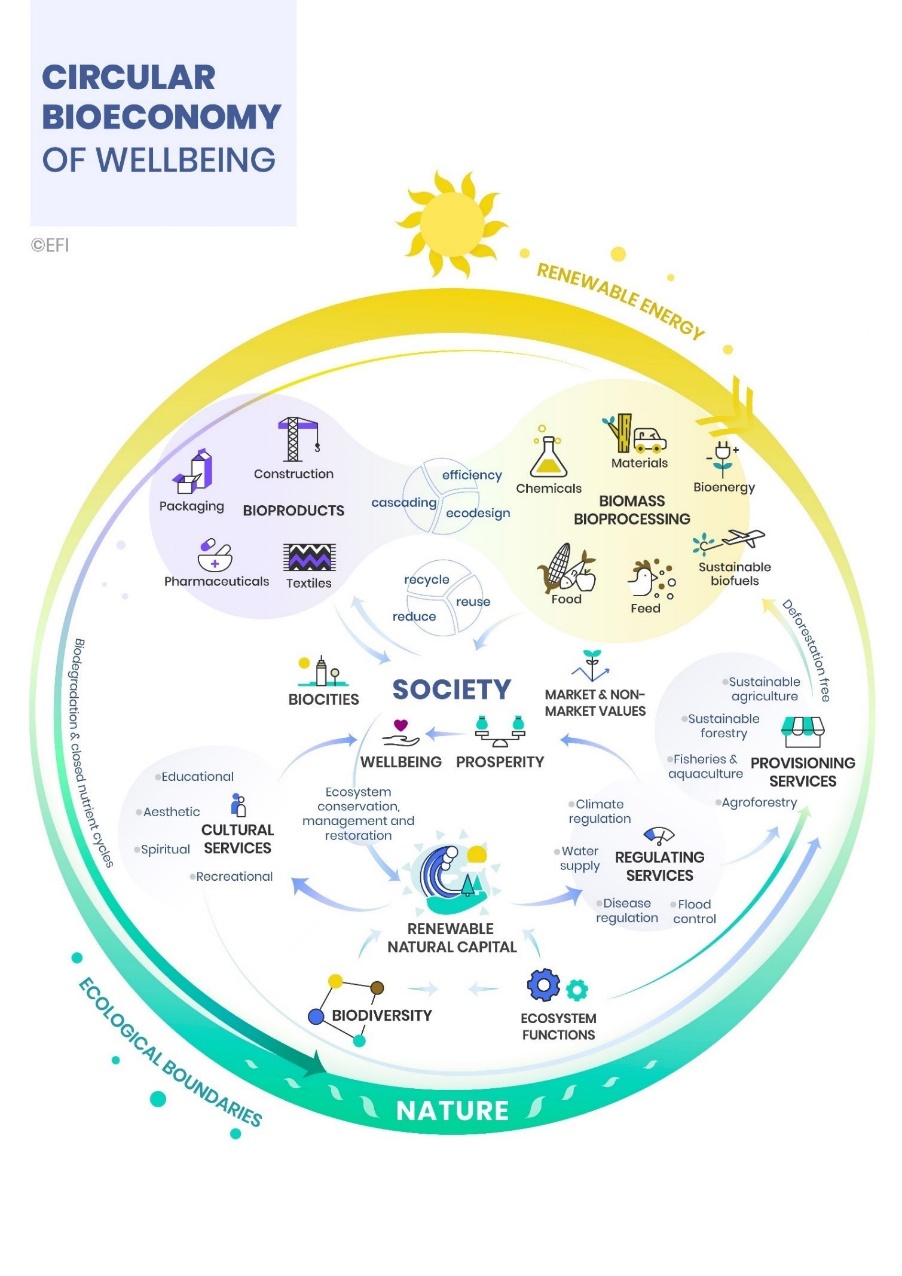
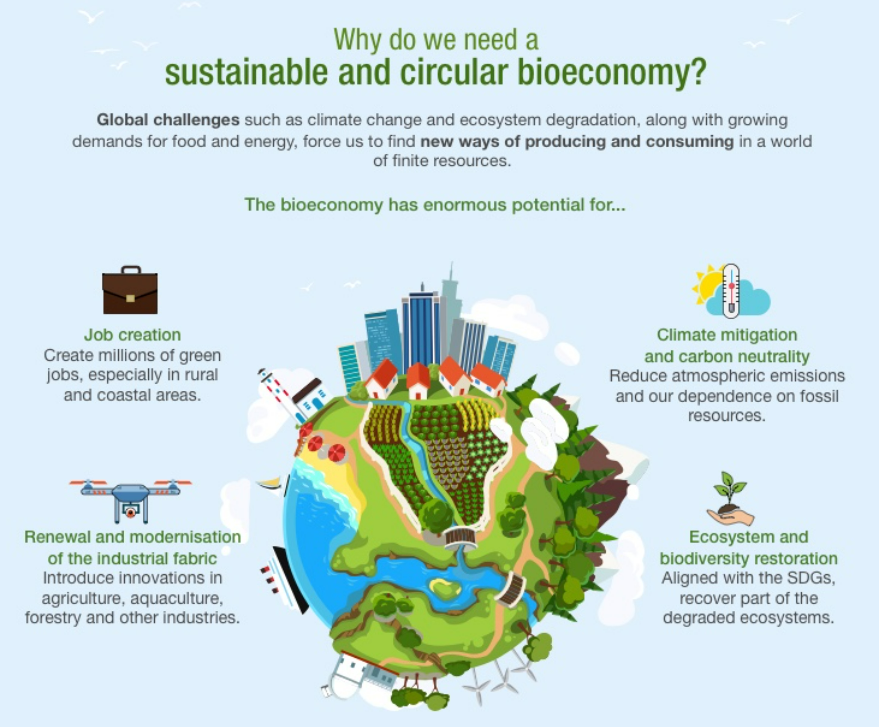
Examples of bioeconomy
Food systems occupy the largest niche in the bioeconomy. To these systems, which include sustainable agriculture, sustainable fishing, forestry and aquaculture, as well as food and feed manufacturing, are added bio-based products and bioenergy. BIo-based products include bioplastics, biodegradable clothing and other products related with eco-design. Like biomass — one of the renewable energies —, bioenergy improves the security of energy supply, reduces energy dependence and creates new opportunities for growth and employment.
.jpg)
How to boost the Bioeconomy?
An appropriate bioeconomic strategy requires the development of an action plan involving local governments, national governments and supranational organisations. In order to promote such a plan, a political framework that promotes multilateralism and enables joint efforts is needed. We review the guidelines to be followed below:
The bioeconomy, the 2030 Agenda and the SDGs
The 2030 Agenda was adopted by the United Nations (UN) in 2015.This action plan encompasses the 17 Sustainable Development Goals (SDGs) and although all of these goals can benefit from the application of the bioeconomy, has found four related areas:
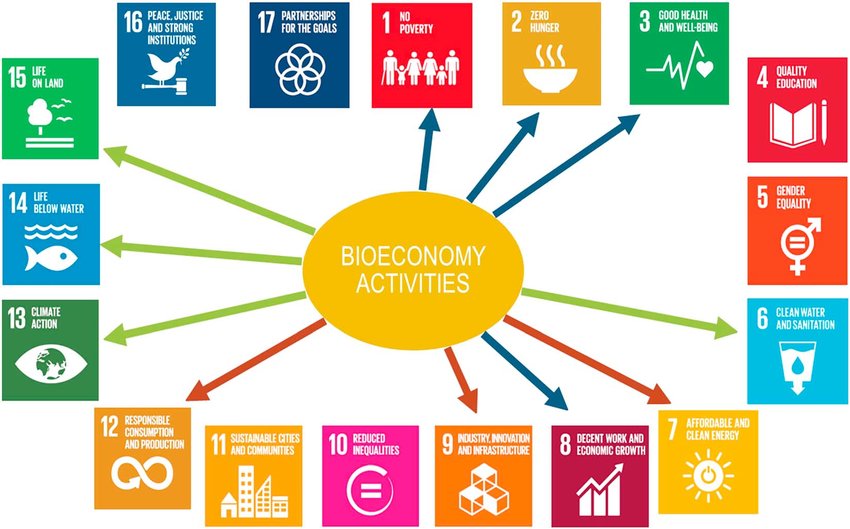
The advantages of the Bioeconomy
The bioeconomy provides solutions to the main challenges facing humanity today, almost all of which are linked to climate change:
A flourishing bioeconomy offers multiple benefits. It reduces dependence on fossil resources (which are limited and pollutant), uses local raw materials, thus curbing greenhouse gas emissions, promotes job creation, economic growth and re-industrialisation.
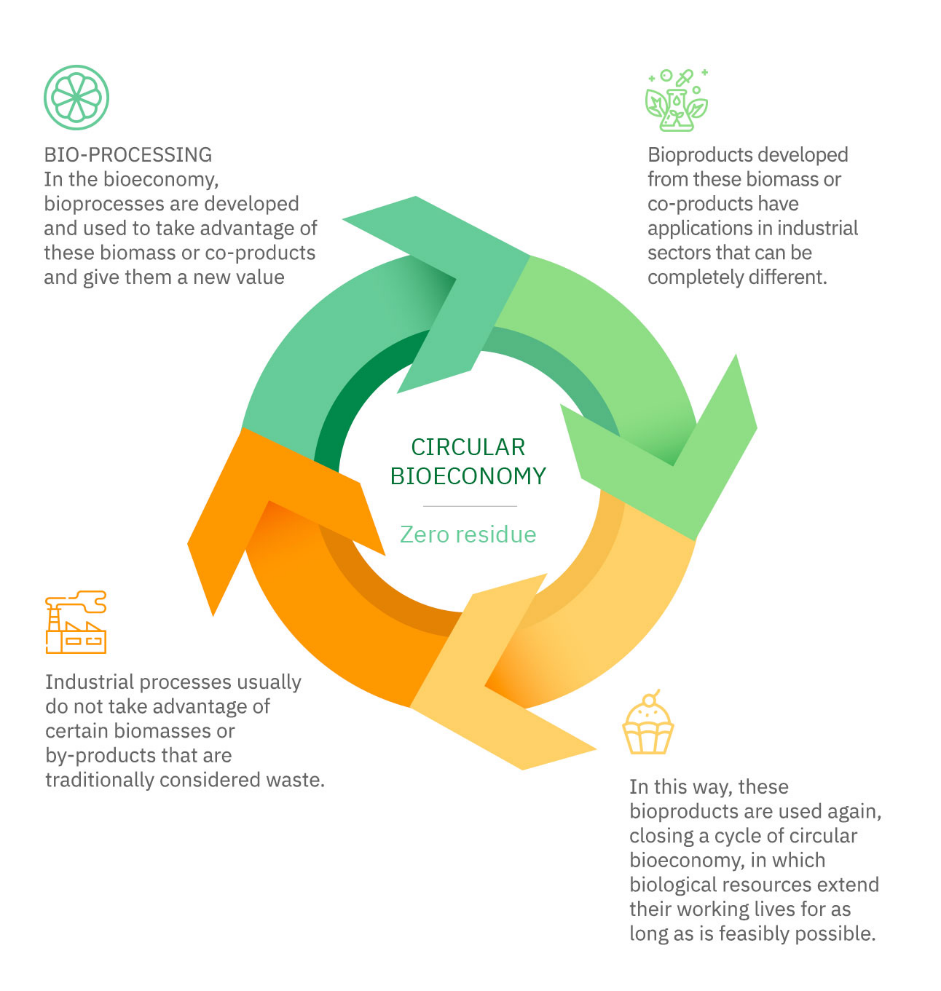
Indian Bio-Economy
The Indian BioEconomy for 2021 (January-December 2021) is estimated at $80.12 billion. The BioEconomy registered 14% growth over 2020. Indian BioEconomy is continued to nearly account for 2.6 percent share of India’s GDP in 2021. India’s BioEconomy continued to perform well during the pandemic years as the BioPharma segment responded to the vaccine and testing needs in India.
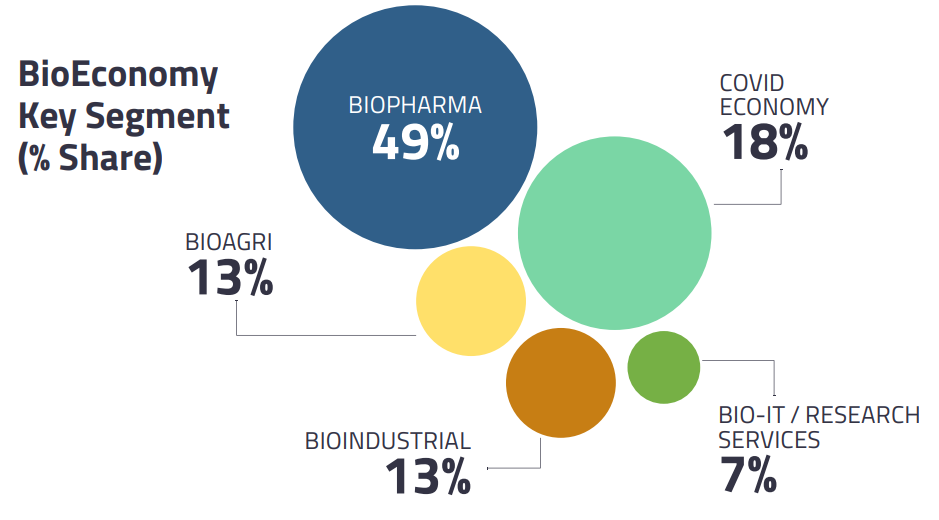
The nation has set an ambitious target for the BioEconomy to touch the $150 billion threshold by 2025. Essentially, the performance of almost all the sectors that contribute to the national BioEconomy has to nearly double in the next 3-4 years to achieve this target.
INDIA SHOULD AIM FOR $ 300 BILLION BIOECONOMY BY 2030
India made biosimilars are getting accepted in developed markets like the USA and we can expect more nations to source cost effective biosimilars in many disease categories as these global quality medical products demonstrate their efficacy and popularity in foreign countries.
The Indian Diagnostics and medical devices market is likely to see a huge jump both in terms of consumption and exports. Covid-19 helped the nation to create the right ecosystem to manufacture, source, and export as well. The Diagnostics Labs services are also reaching across the breadth and width of country. “RTPCR tests” done here is a frequently spotted signs even in small cities and towns across the country, indicating the spread of this expertise Ayushman Bharat is aiding the spread and India’s BioEconomy from Diagnostics services and medical devices products is expected to touch $35 billion by 2025.
Vaccines are expected to generate $15 billion by 2025 and biotherapeutics another $15 billion by 2025. The therapeutics segment is likely to create a BioEconomy of $15 billion from recombinant and biosimilar products.
BioIndustrial is another important sector that has got fillip from the Prime Ministers vision of Atmanirbhar Bharat and India becoming “energy independent” by 2047. The Indian Government has approved the amendments to the National Policy on Biofuels and took decisions to increase biofuel production and advance the introduction of ethanol blended petrol with up to 20% blend from April 2023. The amendments include allowing more feedstocks for the production of biofuels permission for the export of biofuels in specific cases, support developments of indigenous technologies and generate more employment. The Biofuels capacity in the Indian is expected to grow from 5.2 billion liters in 2021 to 10.1 billion liters in 2025 (almost doubling). In terms of the economic value the Biofuel will generate $20 billion BioEconomy by 2025 from $6 billion in 2021 (almost tripling).
BioAgri comprising of Bt Cotton, pesticides, marine biotech, and animal biotech has the potential to nearly double its BioEconomy contribution from $10.5 billion to $20 billion in 2025. The impetus on circular economy will give the needed push to the sector.
BioServices sector comprising of CROs/ CDMOs and BioIT segment is forecast to grow from $6.4 billion to $26.6 billion. The segment will nearly quadruple. Most of the large IT companies have dedicated biotech / health care practice. Nearly 5-6 percent of the total value of company’s income comes from the biotech portion of healthcare and life sciences practice.
New segments like smart proteins, protein and peptide-based materials, contact lens, speech restorers, smart pills, nerve regenerators, portable dialysis, prosthetic limbs, new wave of smart telediagnostics, will create a nearly $10 billion in BioEconomy.
Just take the case of “ alternate foods” or “smart proteins “ India is the preferred destination for both Innovation and manufacture in the ‘Smart Protein area. There is a very big demand for fermentation capacities in this area from startups in US. We have already seen some of the investment happening and in the next 3-5 years there is a potential for 10 million litre fermentation capacities to be set up in India. This will attract an investment of more than $ 500 million which will generate a revenue of $1 billion every year. These facilities could be located in strategic places which has all the infrastructure for setting these big fermentation faculties. The industry just needs the support from a regulatory and infrastructure point of view to capitalise on this great emerging opportunity.
Thus, India’s BioEconomy has the potential to reach $270-300 Billion by the year 2030 and account for nearly 3.3-3.5 % share of India’s GDP from the 2.8 percent share in 2021.
Transforming India into a Bio-economy
Here are some steps that can be taken to aid the development of biotech in India
Bio-industry is all set to boom in the coming years. The solution to our environmental crisis is right in front of us, and corporations have a huge opportunity to make name for themselves in the “Bio era”.
Wrapping it up
The number of biotech Startups in the country has increased from 50 to over 5,300 in the last 10 years, because of the growing enabling ecosystem. Bioeconomy will be key to India's future economy over the next 25 years.
Animal Welfare Board of India
Context
About
Longewala Battle
Context
Battle of Longewala
National Anti-Doping Agency of India (NADA)
Context
About
WADA
PARIS CLUB
Context
About
© 2024 iasgyan. All right reserved